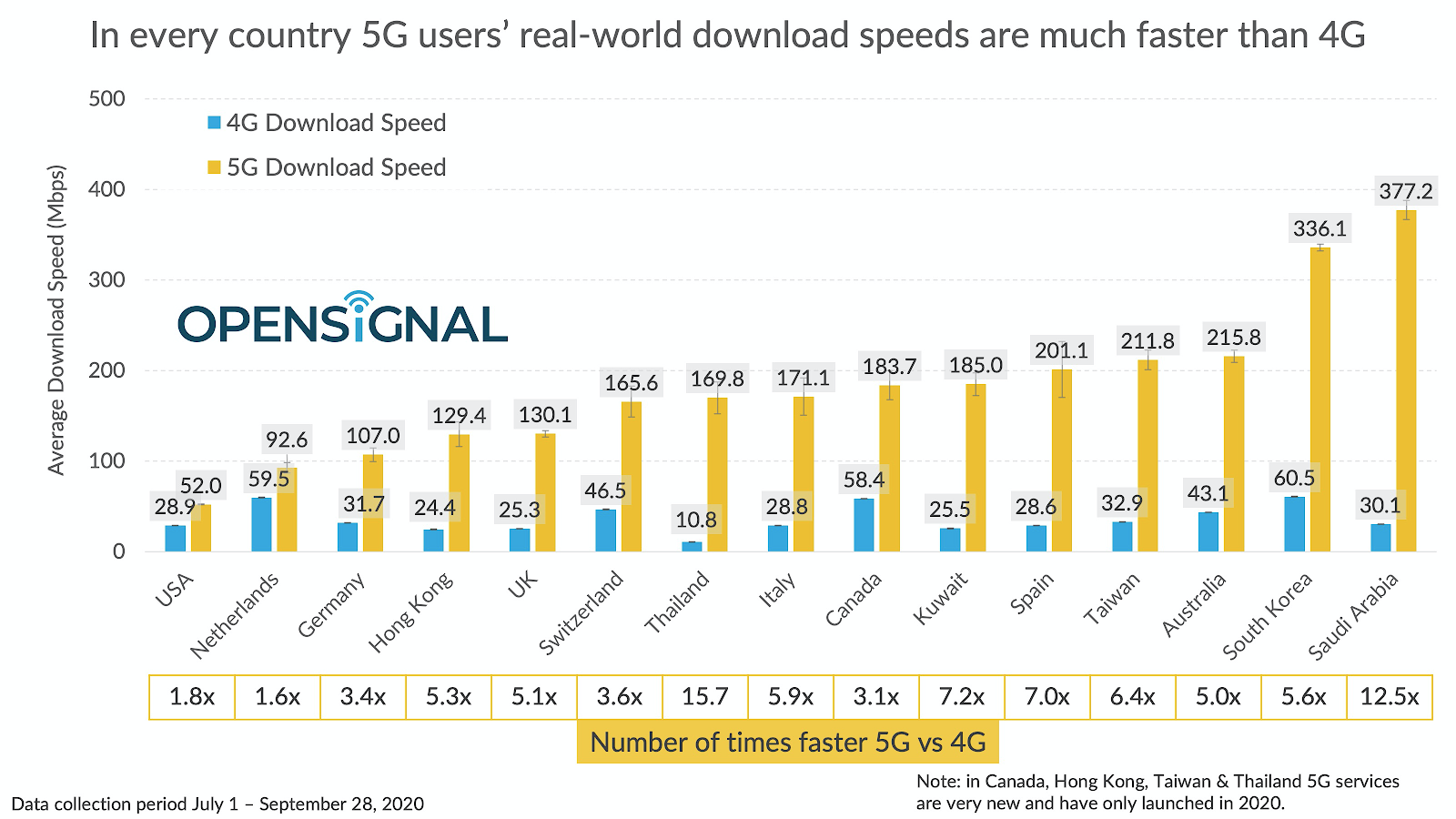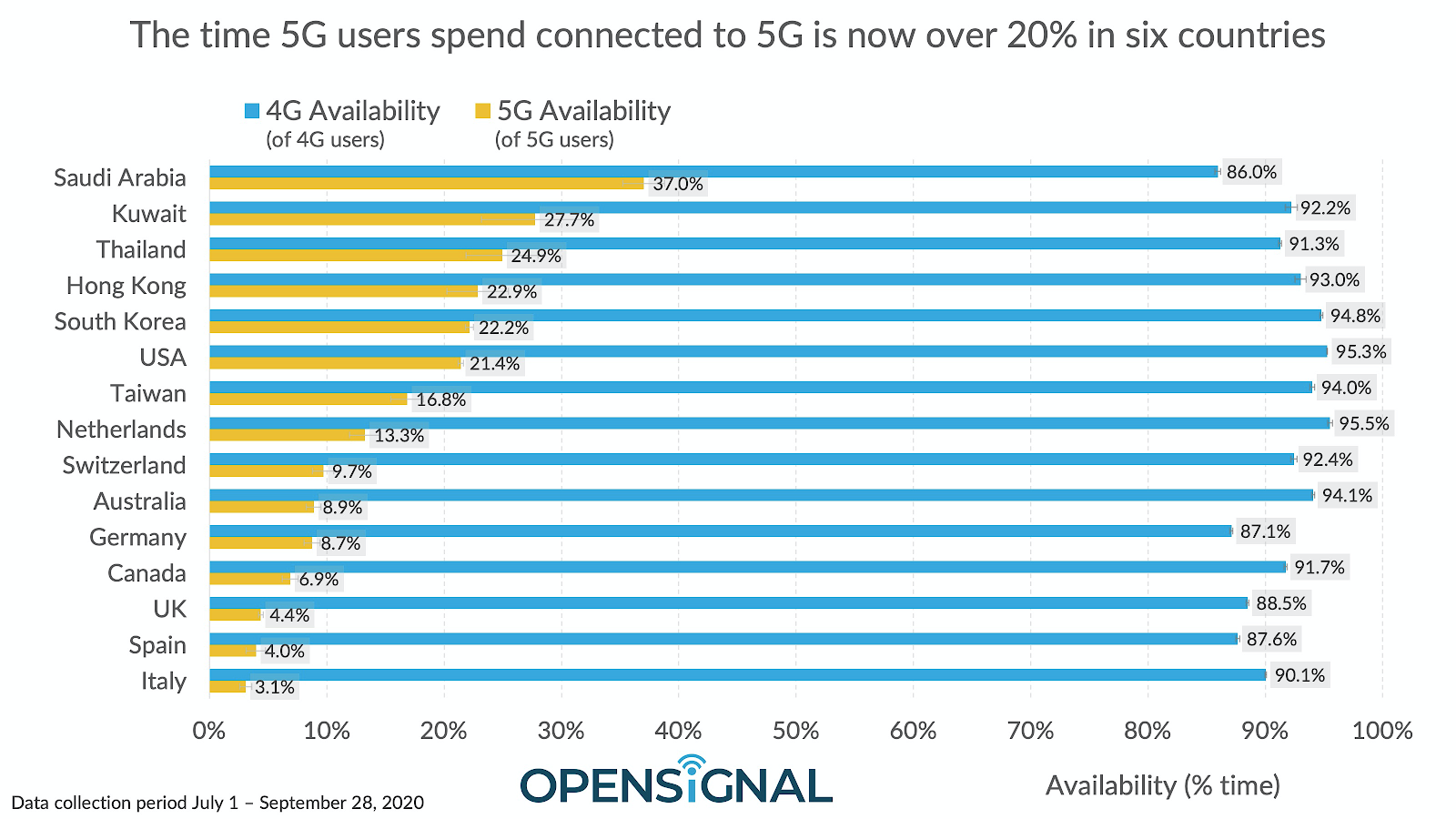Opensignal has previously analyzed the real-world 5G experience of our users across mobile operators in a number of countries globally, including Australia, the U.S. and South Korea.
Now, we are publishing a new look at the 5G experience across fifteen leading 5G markets. In every country, 5G users see average download speeds many times faster than 4G. The improvement in 5G speeds ranges from 15.7 times faster than 4G in Thailand to 1.6 times faster in the Netherlands. Across these countries, users see 5G download speeds that are 5 to 6 times faster than 4G.

Our users in Saudi Arabia continue to see the fastest average download speeds using 5G technologies with an average speed of 377.2 Mbps, which is slightly faster than the 336.1 Mbps seen in South Korea. In all but two countries, our users see average 5G download speeds over 100 Mbps. Speed is by no means the only 5G measure that matters — how long users spend connected to the much faster 5G technology is also extremely important. Often, our users spend more time connected to 5G networks in those countries where we record slower 5G speeds.

The modest 5G Download Speeds in the U.S. are due to the combination of a limited amount of new mid-band 5G spectrum available now and the widespread use of low-band spectrum by operators. For example, T-Mobile’s 600MHz and AT&T’s 850MHz offer excellent availability and reach but lower average speeds than the 3.5GHz mid-band spectrum used as the main 5G band in every country outside of the U.S. However, in our recent U.S. report we found that Verizon’s mmWave-based 5G service offers a very considerably faster average 5G Download Speeds of 494. 7 Mbps, which is faster than the average 5G download speeds Opensignal has seen on any operator, or in any country to date, including Saudi Arabia.
The amount of time users spend connected to 5G — or 5G Availability — is an important factor in the overall experience 5G users enjoy. We are still in the early stages of a 5G era that will last for at least a decade because the first 5G services launched only in 2019, and in a number of countries we continue to see 5G mobile services launching for the first time.
Despite this immature 5G market, Opensignal’s data now shows that our users in five countries enjoy an active 5G connection for more than one fifth of the time. We see U.S. 5G users connect 21.4% of the time to 5G, placing the U.S. in the fifth place for 5G Availability, only just behind South Korea and ahead of six European countries.

The U.S. is much higher ranked on 5G Availability than on average download speed because low-band spectrum is ideally suited to enable greater 5G reach and allow users to spend more time connected than in countries where higher frequency 5G spectrum is commonly used. In the U.S. the low-band 5G services of T-Mobile and AT&T have helped drive a high 5G Availability result. T-Mobile U.S.’s very recent launch of standalone access 5G — where a phone no longer needs to connect to 4G in order for 5G to work — should help boost 5G Availability and network responsiveness in future.
Clearly, smaller geographies like Kuwait or Hong Kong have an advantage over large countries like Australia or the U.S. in offering users high levels of 5G Availability which makes the achievements of operators in both Australia and the U.S. — powering their 5G users’ experience ahead of the U.K, and Switzerland — all the more impressive.
Opensignal Limited retains ownership of this insight including all intellectual property rights, data, content, graphs & analysis. Reports and insights produced by Opensignal Limited may not be quoted, reproduced, distributed, published for any commercial purpose (including use in advertisements or other promotional content) without prior written consent. Journalists are encouraged to quote information included in Opensignal reports and insights provided they include clear source attribution. For more information, contact [email protected].
